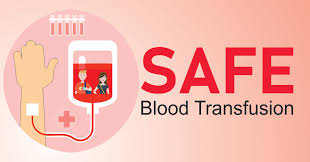Ensuring Health and Life with Best Practices
Blood transfusion is a life-saving medical procedure used to replace blood lost due to surgery, injury, or disease. It plays a crucial role in modern healthcare, enabling treatment for a wide range of conditions, from trauma and surgery to chronic illnesses like anemia and cancer. While blood transfusions save millions of lives every year, they are not without risks. Therefore, ensuring blood transfusion safety is paramount to protect recipients from potential complications.

The Importance of Blood Transfusion Safety
Blood is a precious and irreplaceable resource for blood transfusion safety. However, blood transfusion is not just about giving blood; it’s about giving the right blood safely to the right person. The process involves several stages, each requiring strict adherence to safety protocols. These stages include donor selection, blood testing, storage, matching, and transfusion. Any lapse in these procedures can result in adverse reactions, infections, or other serious health complications.
Blood transfusion safety aims to reduce the risk of transfusion-transmissible infections (TTIs), immune reactions, and other transfusion-related complications.
Key Aspects of Blood Transfusion Safety
1. Donor Screening and Selection of blood transfusion safety
The first step in ensuring the safety of blood transfusion is careful screening and selection of blood donors. Blood donation centres must adhere to stringent guidelines to identify healthy individuals who are eligible to donate blood. A thorough screening process is carried out before the donation to ensure that donors do not have medical conditions or behaviours that could jeopardize the safety of the donated blood.
Potential donors are asked to fill out a detailed questionnaire covering their medical history, recent travel, medication use, and risk behaviours (such as unsafe sexual practices or drug use). Additionally, donors undergo a physical examination, including checking vital signs like blood pressure and hemoglobin levels, to confirm they are healthy enough to donate.
Blood transfusion safety donor selection plays a crucial role in minimizing the risk of transfusion-transmitted infections. Excluding individuals with known risk factors ensures that only the safest blood is collected.
2. Blood Testing and Screening for Infectious Diseases
After the blood is collected, it undergoes rigorous testing to detect any infectious agents or abnormalities. The blood is screened for transfusion-transmissible infections, including:
HIV (Human Immunodeficiency Virus)
Hepatitis B and C
Syphilis
West Nile Virus
Malaria (in some regions)
The introduction of nucleic acid testing (NAT) has further increased the sensitivity of these tests, allowing earlier detection of infections in donated blood. This technology has been instrumental in reducing the risk of transmitting infectious diseases through blood transfusion.
In addition to testing for infectious agents, blood is also typed for ABO and Rh compatibility. This ensures that the donated blood matches the recipient’s blood type and reduces the risk of transfusion reactions.
3. Blood Component Separation and Storage
in the blood transfusion safety whole blood collected from donors is rarely transfused as is. Instead, it is separated into its various components—red blood cells, plasma, platelets, and cryoprecipitate—each of which has a different medical use. For example, red blood cells are used to treat anemia, while plasma is used to manage bleeding disorders.
4. Crossmatching and Compatibility Testing
Before transfusing blood into a patient, it is critical to ensure compatibility between the donor’s blood and the recipient’s blood. Crossmatching is a laboratory test that confirms the blood compatibility between the donor and recipient. This step is particularly important for individuals who may have developed antibodies due to previous transfusions, pregnancies, or organ transplants.
The process involves mixing a small sample of the donor’s blood with the recipient’s blood to check for any adverse reactions. If no reaction occurs, the blood is deemed compatible, and the transfusion can proceed safely. Failing to crossmatch properly can lead to hemolytic transfusion reactions, which can be life-threatening.
5. Safe Blood Administration
Administering blood safely requires trained healthcare professionals who are familiar with transfusion protocols and procedures. The transfusion team must carefully monitor the recipient throughout the process to detect any adverse reactions early on. This involves checking vital signs, such as blood pressure, heart rate, and temperature, before, during, and after the transfusion.
Blood Transfusion Safety reactions can range from mild allergic reactions to severe anaphylaxis or hemolysis. While serious reactions are rare, healthcare providers are trained to respond quickly to any complications. In some cases, premedication (e.g., antihistamines) may be given to reduce the risk of allergic reactions.
Additionally, the transfusion team must ensure that the correct blood product is given to the correct patient. Mislabeled or misidentified blood can lead to catastrophic outcomes. To prevent this, hospitals and blood banks implement strict labelling and identification systems, including barcode scanning and double-checking patient information.
6. Post-Transfusion Monitoring and Reporting
After the transfusion is completed, the patient must be monitored for any delayed reactions or complications. Some adverse effects, such as transfusion-associated circulatory overload (TACO) or transfusion-related acute lung injury (TRALI), may develop hours or even days after the transfusion.
In the event of an adverse reaction, healthcare facilities are required to report the incident to relevant authorities. This reporting system helps track trends, identify potential issues, and improve transfusion safety on a larger scale.
However, disparities in healthcare infrastructure mean that not all regions have access to the same level of safety. In low- and middle-income countries, access to safe blood can be limited by inadequate testing, lack of trained personnel, or insufficient blood supply.
The WHO’s Global Action Plan for Universal Access to Safe Blood aims to ensure that all countries have safe, sufficient, and sustainable blood supplies. This includes encouraging voluntary, non-remunerated blood donation, which is considered the safest source of blood in blood transfusion safety.
Conclusion
Blood transfusion safety is a critical component of modern healthcare, protecting patients from potentially life-threatening complications. From donor screening to post-transfusion care, each step of the process must be carefully managed to ensure the safest possible outcome for recipients. While significant progress has been made, ongoing efforts are needed to further improve transfusion safety, especially in resource-limited settings.


